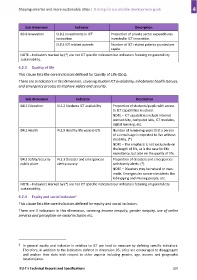Page 817 - Shaping smarter and more sustainable cities - Striving for sustainable development goals
P. 817
Sub‐dimension Indicator Description
D3.8 Innovation I3.8.2 Investments in ICT Proportion of private sector expenditures
innovation invested in ICT innovation.
I3.8.3 ICT related patents Number of ICT related patents granted per
capita.
NOTE – Indicators marked by (*) are not ICT specific indicators but indicators focusing on general city
sustainability.
6.2.3 Quality of life
This clause lists the core indicators defined for Quality of Life (QoL).
There are 3 indicators in this dimension, covering student ICT availability, inhabitants health statues,
and emergency process to improve safety and security.
Sub‐dimension Indicator Description
D4.1 Education I4.1.2 Students ICT availability Proportion of students/pupils with access
to ICT capabilities in school.
NOTE – ICT capabilities include Internet
connectivity, computer labs, ICT modules,
digital learning, etc.
D4.2 Health I4.2.5 Healthy life years (HLY) Number of remaining years that a person
of a certain age is expected to live without
disability. (*)
NOTE – The emphasis is not exclusively on
the length of life, as is the case for life
expectancy, but also on the quality of life.
D4.3 Safety/security I4.3.3 Disaster and emergencies Proportion of disasters and emergencies
public place alert accuracy with timely alerts. (*)
NOTE – Disasters may be natural or man‐
made. Emergencies concern incidents like
kidnapping and missing people, etc.
NOTE – Indicators marked by (*) are not ICT specific indicators but indicators focusing on general city
sustainability.
6.2.4 Equity and social inclusion
3
This clause lists the core indicators defined for equity and social inclusion.
There are 4 indicators in this dimension, covering income inequity, gender inequity, use of online
services and perception on social inclusion etc.
3 In general equity and inclusion in relation to ICT are hard to measure by defining specific indicators.
Therefore, in addition to the indicators defined in dimension D5, cities are encouraged to disaggregate
and analyse their data with respect to other aspects including gender, age, income and geographic
location/area.
ITU‐T's Technical Reports and Specifications 807

